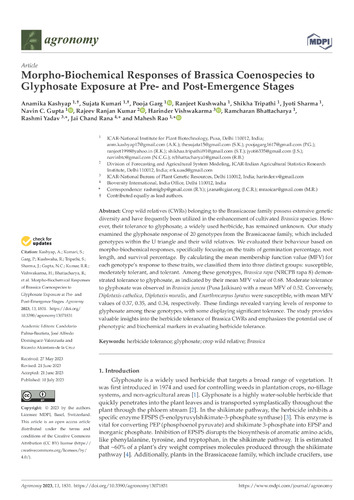Morpho-biochemical responses of Brassica Coenospecies to glyphosate exposure at pre- and post-emergence stages
Crop wild relatives (CWRs) belonging to the Brassicaceae family possess extensive genetic diversity and have frequently been utilized in the enhancement of cultivated Brassica species. However, their tolerance to glyphosate, a widely used herbicide, has remained unknown. Our study examined the glyphosate response of 20 genotypes from the Brassicaceae family, which included genotypes within the U triangle and their wild relatives. We evaluated their behaviour based on morpho-biochemical responses, specifically focusing on the traits of germination percentage, root length, and survival percentage. By calculating the mean membership function value (MFV) for each genotype’s response to these traits, we classified them into three distinct groups: susceptible, moderately tolerant, and tolerant. Among these genotypes, Brassica rapa (NRCPB rapa 8) demonstrated tolerance to glyphosate, as indicated by their mean MFV value of 0.68. Moderate tolerance to glyphosate was observed in Brassica juncea (Pusa Jaikisan) with a mean MFV of 0.52. Conversely, Diplotaxis catholica, Diplotaxis muralis, and Enarthrocarpus lyratus were susceptible, with mean MFV values of 0.37, 0.35, and 0.34, respectively. These findings revealed varying levels of response to glyphosate among these genotypes, with some displaying significant tolerance. The study provides valuable insights into the herbicide tolerance of Brassica CWRs and emphasizes the potential use of phenotypic and biochemical markers in evaluating herbicide tolerance.

